The climate target bill has now passed the lower house after strengthening by Greens and ‘teal’ cross-benchers, and support from Liberal MP Bridget Archer who crossed the floor to vote with the government for climate action.
This is a milestone for climate action in Australia, made possible with community support, collaboration, innovation and bravery.
It comes following the State of the Environment, released two weeks ago, which the new federal Minister for the Environment and Water, Tanya Plibersek, said was a “shocking document” that told “a story of crisis and decline in Australia’s environment, and of a decade of government inaction and wilful ignorance”.
Plus we have just seen the CSIRO report into the mega-trends shaping our future predicted that climate change is set to triple the cost of natural disasters in Australia without urgent government spending on resilience.
While dreadful, this message has been a long time coming and it reflects a failure and a challenge beyond any one political party. What we see now is that this isn’t just a climate and a biodiversity crisis.
This is fundamentally a leadership crisis.
The first time I read an IPCC report (the climate science reports that inform the global negotiations) was in 2007. I was excited to make a difference, and was determined to understand what we were up against. I remember being devastated, but also feeling that at least now we knew what the challenge was, and what to do about it.
Fast forward to 15 years later, and as I read these latest reports I found myself asking, what’s changed?
Momentum, action, community support – absolutely. But is it enough? Absolutely not. The situation is so much worse, and accelerating quickly. More quickly than our latest climate target bill can address.
It’s time that we asked ourselves the following questions: What does leadership for our environment and climate look like? Who is really leading, and if they aren’t why not?
And then we need to ask whether the leadership we have today across politics, business and our communities is up to the challenges we face?
The answer to that last question is clear. Leadership in Australia to date has failed to adequately address these challenges. We need a leadership change. Not just new faces, but a new style.
This is why women’s leadership for our environment should be seen as an important solution.
The type of leadership on display in the last week with the collaborative approach of the independent “teal” MPs and Dr Sophie Scamps, who in her maiden speech prioritised listening and action to tackling the worst impacts of climate change. This was followed up by the actions of Liberal MP Bridget Archer who listened to her community and acted beyond the norms of party machinery by crossing the floor to vote with the government for climate action.
International evidence from studies across business and politics demonstrates that more women in decision making results in better environmental outcomes.
While diverse voices will always bring different perspectives and approaches and should be supported more generally, one of the most important factors is how those voices are empowered to lead.
When women and gender diverse people from a full variety of backgrounds and communities are empowered and allowed to lead in the ways that they identify and that works for them – that’s when you can really get something different.
Research by Professor Amanda Sinclair at the Melbourne Business School demonstrates that where women are given space to step outside of the existing models and norms that dominate their organisations or communities, and are able to identify their own way of working, they tend to consistently reject hierarchy, put effort into building relationships and empowering others, and emphasise collective achievement and responsibility.
We also see that there is no one way of women leading, and in fact there is considerable diversity in the way women go about the job of leadership. This is a way of working that involves relationships, networks, and collaboration, and at its best, embraces these strategically.
This is quite different to traditional models of leadership which have been seen as masculine, heroic and individual. A model that reinforces self-reliance, assertiveness and competition. This has been established over millennia in western culture, where military and political strategy and leadership written and established by men, has been handed down and refined by men. The way this norming of behaviour plays out in organisations is that only people who act within the bounds seen as ‘leadership’, can be seen as future leaders.
This is a problem – for equity and diversity, and for our environment.
Because the people and the leadership styles that got us into this mess that the State of the Environment report outlines, simply aren’t going to the same people and leadership styles that get us out of it.
We need change. As a new wave of women elected to our federal parliament take their seats in the House and the Senate due to a wave of community activism, there is hope that this new style might yet be possible at decision making tables across the country.
Relationships enable collaboration. Collaboration is the genesis of innovation. And we are in desperate need of innovation across all aspects of our society, our politics and our economic activity.
What we see in diverse women’s leadership – relationships, collaboration, innovation – are the skills and approaches essential to the transition to a sustainable future.
If we want to win, we need more women and gender-diverse people leading – from all levels, in all sectors, in formal and informal roles.
This revolution of leadership is ours for the making.


